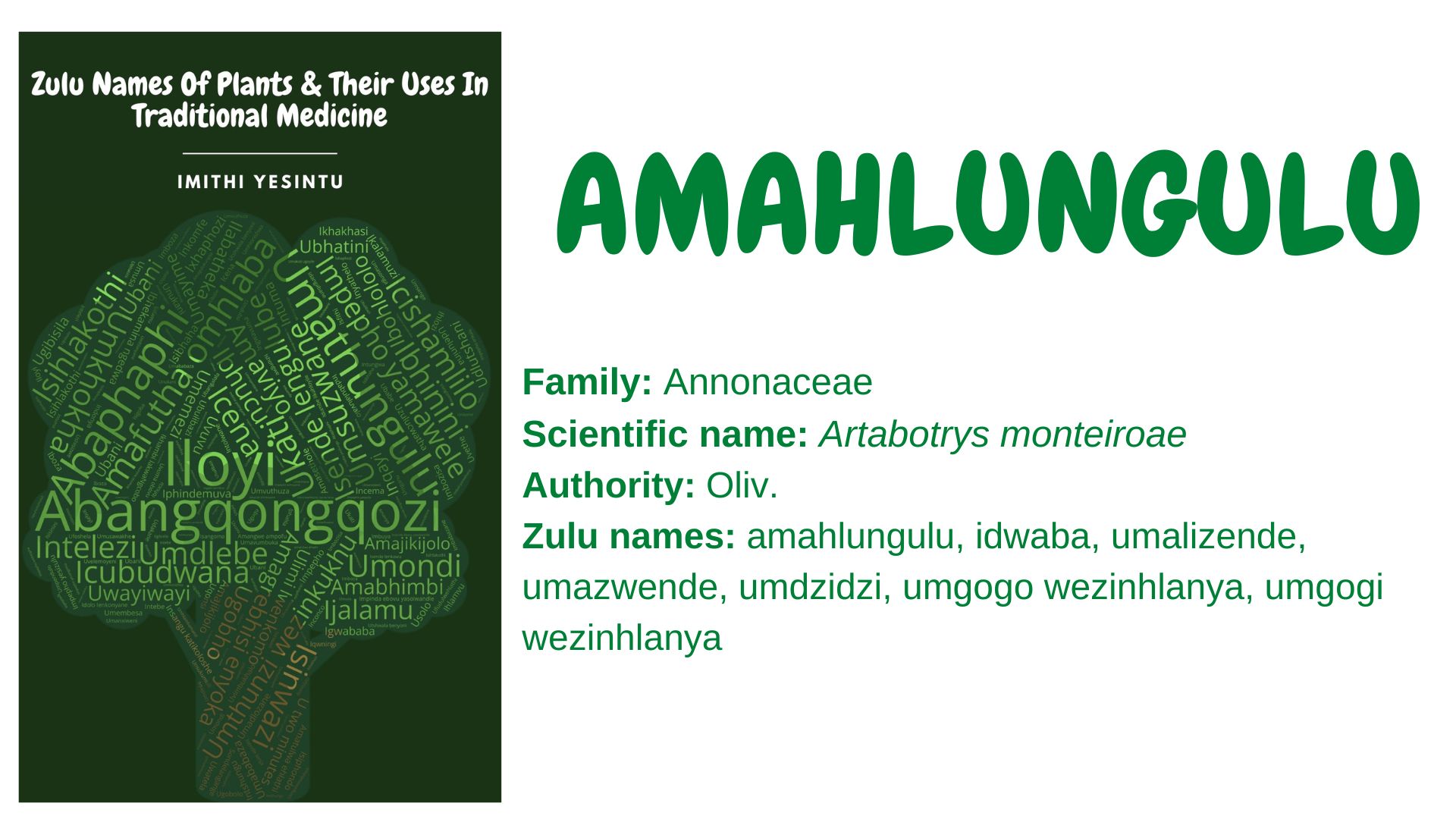Family: Annonaceae
Scientific name: Artabotrys monteiroae
Authority: Oliv.
Synonym: Artabotrys nitidus Engl.
Zulu names: amahlungulu, idwaba, umalizende, umazwende, umdzidzi, umgogo wezinhlanya, umgogi wezinhlanya
Other names: red hook berry
Plant description: A. monteiroae is a scrambling shrub (or small tree) that grows in the woodland and thicket habitats. It has leathery leaves that are glossy and dark green above and dull green beneath, deep yellow to cream flowers, and carpel fruits in a cluster that turn red when ripe.
Uses:
- The edible fruits are eaten as food.
- The fruits are used to make alcoholic beverages.
- The roots are used to make a sedative to induce sleep and to treat back pain.
- The roots are mixed with Haemanthus albiflos to treat hysteria.
- The plant is used in the treatment of izizwe, spirit possession.
- The roots are used as an ingredient to make umuthi omhlophe, a tonic.
- The roots are used to treat digestive and stomach disorders.
- The roots and bark are used as a decoction to treat malaria.
- The leaves are used to make a bathing agent.
- The plant is used to make an emetic.
- The plant is used to treat blennorrhagia (gonorrhoea).
- The plant is used by sorcerers to cause sickness.
- The plant is cultivated as a hedge for fencing.
Safety precaution:
Using traditional medicine responsibly can enhance your overall health and well-being. Misuse and abuse can lead to complications. You can inquire about the correct use of traditional medicine from a knowledgeable herbalist and practitioner. You can also visit imithiyesintu.co.za or email: info@imithiyesintu.co.za to learn more about traditional medicine
References and further reading:
- Cock, I.E., Selesho, M.I. and Van Vuuren, S.F., 2019. A review of the traditional use of southern African medicinal plants for the treatment of malaria. Journal of ethnopharmacology, 245, p.112176.
- Fowler, D.G., 2006. Traditional fever remedies: a list of Zambian plants. Kirkia, 18(19), pp.35-48.
- Mbanjwa, S.G., 2020. A quantitative ethnobotanical survey of the Ixopo area of KwaZulu-Natal, South Africa. University of Johannesburg (South Africa).
- Mhlongo, L.S., 2019. The Medicinal Ethnobotany of the Amandawe Area in KwaCele, KwaZulu-Natal, South Africa. University of Johannesburg (South Africa).
- Mokganya, M.G., Tshisikhawe, M.P., Swelankomo, N., Tshivhandekano, T.R., Ramovha, L.I., Masevhe, N.A., Ligavha-Mbelengwa, M.H. and Mocheki, T.A., 2018. An evaluation of additional uses of some wild edible fruit plants of the Vhembe District Municipality in the Limpopo Province, South Africa.
- Sitoe, E., 2020. Medicinal ethnobotany of Mozambique: A review and analysis. University of Johannesburg (South Africa).
- Tan, K.K. and Wiart, C., 2014. Botanical descriptions, ethnomedicinal and non-medicinal uses of the genus Artabotrys R. BR. Int J Curr Pharm Res, 6(1), pp.34-40.
- Tulelo, P.M. and Mulaudzi, F.M., 2021. Indigenous neonatal feeding and bathing practices of caregivers in Vhembe District, Limpopo province. Health SA Gesondheid, 26.
- Watt, J.M. and Breyer-Brandwijk, M.G., 1962. Medicinal and poisonous plants of southern and eastern Africa, second edition. Livingstone, London.
You Can Order Your Copy Of The Book By Emailing: info@imithiyesintu.co.za
Feel Free To Add Other Uses Of This Plant In The Comment Section Below:

